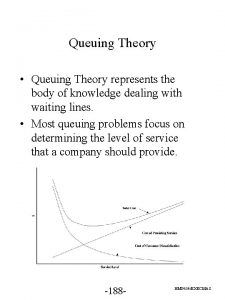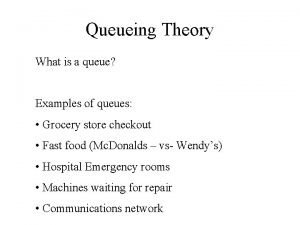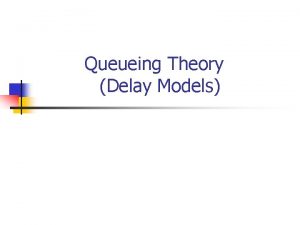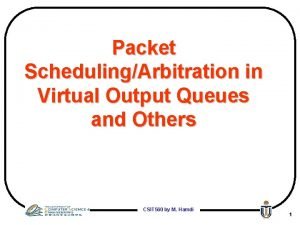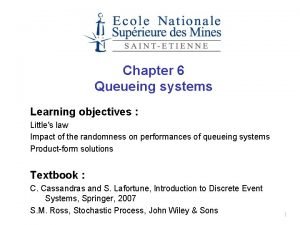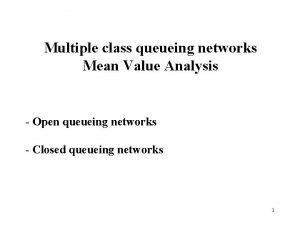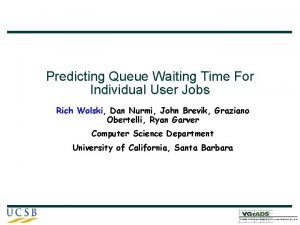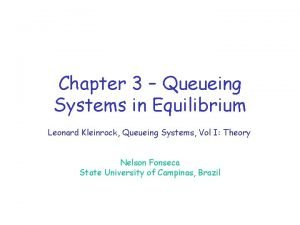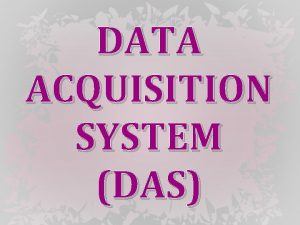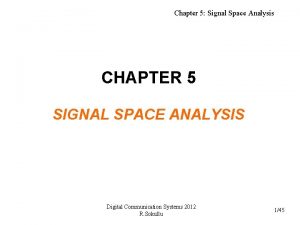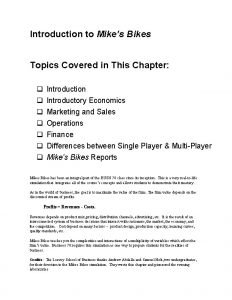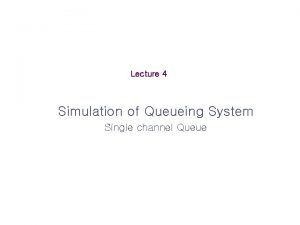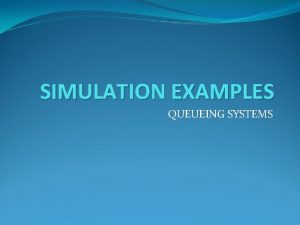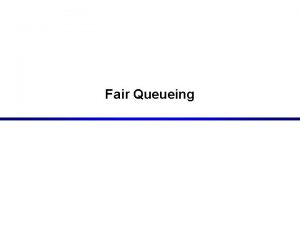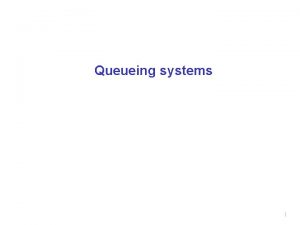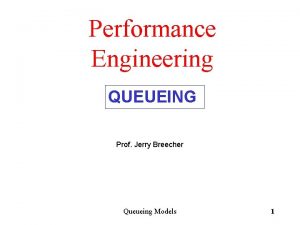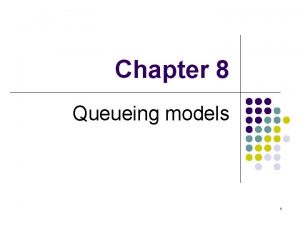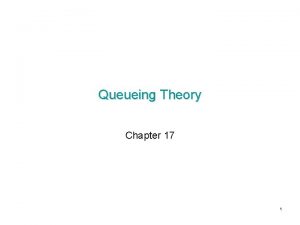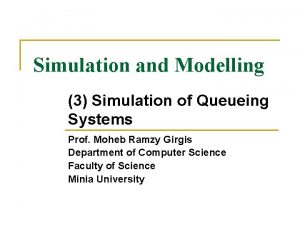Lecture 3 Simulation of Queueing System Single channel
















- Slides: 16

Lecture 3 Simulation of Queueing System Single channel Queue

Simulation Examples Three steps of the simulations n Determine the characteristics of each of the inputs to the simulation. Quite often, these may be modeled as probability distributions, either continuous or discrete. n Construct a simulation table. Each simulation table is different, for each is developed for the problem at hand. n For each repetition i, generate a value for each of the p inputs, and evaluate the function, calculating a value of the response yi. The input values may be computed by sampling values from the distributions determined in step 1. A response typically depends on the inputs and one or more previous responses.

The simulation table provides a systematic method for tracking system state over time. Inputs Repetitions 1 2 · · · n Xi 1 Xi 2 … Xij Response … Xip yi

Simulation of Queueing Systems (1) Calling population Waiting Line Server Fig. 2. 1 Queueing System A queueing system is described by its calling population, the nature of the arrivals, the service mechanism, the system capacity, and the queueing discipline.

Simulation of Queueing Systems (2) In the single-channel queue, the calling population is infinite. n If a unit leaves the calling population and joins the waiting line or enters service, there is no change in the arrival rate of other units that may need service. Arrivals for service occur one at a time in a random fashion. n Once they join the waiting line, they are eventually served. Service times are of some random length according to a probability distribution which does not change over time. The system capacity has no limit, meaning that any number of units can wait in line. Finally, units are served in the order of their arrival (often called FIFO: First In, First out) by a single server or channel.

Simulation of Queueing Systems (3) Arrivals and services are defined by the distribution of the time between arrivals and the distribution of service times, respectively. For any simple single- or multi-channel queue, the overall effective arrival rate must be less than the total service rate, or the waiting line will grow without bound. n In some systems, the condition about arrival rate being less than service rate may not guarantee stability

Simulation of Queueing Systems (4) System state : the number of units in the system and the status of the server(busy or idle). Event : a set of circumstances that cause an instantaneous change in the state of the system. n In a single-channel queueing system there are only two possible events that can affect the state of the system. w the arrival event : the entry of a unit into the system w the departure event : the completion of service on a unit. Simulation clock : used to track simulated time.

Simulation of Queueing Systems (5) If a unit has just completed service, the simulation proceeds in the manner shown in the flow diagram of Figure 2. 2. n Note that the server has only two possible states : it is either busy or idle. Departure Event Begin server idle time No Another unit waiting? Yes Remove the waiting unit from the queue Begin servicing the unit Fig. 2. 2 Service-just-completed flow diagram

Simulation of Queueing Systems (6) The arrival event occurs when a unit enters the system. n The unit may find the server either idle or busy. w Idle : the unit begins service immediately w Busy : the unit enters the queue for the server. Arrival Event Unit enters service No Server busy? Yes Unit enters queue for service Fig. 2. 3 Unit-entering-system flow diagram

Simulation of Queueing Systems (7) Fig. 2. 4 Potential unit actions upon arrival Fig. 2. 5 Server outcomes after service completion

Simulation of Queueing Systems (8) Simulations of queueing systems generally require the maintenance of an event list for determining what happens next. Simulation clock times for arrivals and departures are computed in a simulation table customized for each problem. In simulation, events usually occur at random times, the randomness imitating uncertainty in real life. Random numbers are distributed uniformly and independently on the interval (0, 1). Random digits are uniformly distributed on the set {0, 1, 2, … , 9}. The proper number of digits is dictated by the accuracy of the data being used for input purposes.

Simulation of Queueing Systems (9) Pseudo-random numbers : the numbers are generated using a procedure. Table 2. 2. Interarrival and Clock Times n Assume that the times between arrivals were generated by rolling a die five times and recording the up face.

Simulation of Queueing Systems (10) Table 2. 3. Service Times n n Assuming that all four values are equally likely to occur, these values could have been generated by placing the numbers one through four on chips and drawing the chips from a hat with replacement, being sure to record the numbers selected. The only possible service times are one, two, three, and four time units.

Simulation of Queueing Systems (11) The interarrival times and service times must be meshed to simulate the single-channel queueing system. Table 2. 4 was designed specifically for a single-channel queue which serves customers on a first-in, first-out (FIFO) basis.

Simulation of Queueing Systems (12) Table 2. 4 keeps track of the clock time at which each event occurs. The occurrence of the two types of events(arrival and departure event) in chronological order is shown in Table 2. 5 and Figure 2. 6 is a visual image of the event listing of Table 2. 5. The chronological ordering of events is the basis of the approach to discrete-event simulation.

Simulation of Queueing Systems (13) Figure 2. 6 depicts the number of customers in the system at the various clock times.
 Types of multi channel retailing
Types of multi channel retailing Waiting line management system
Waiting line management system Queuing theory formula
Queuing theory formula Queueing theory
Queueing theory Mm1 queue formulas
Mm1 queue formulas Virtual output queueing
Virtual output queueing Littles law
Littles law Queueing
Queueing Predictive queueing
Predictive queueing Kleinrock queueing systems
Kleinrock queueing systems Single channel and multichannel data acquisition system
Single channel and multichannel data acquisition system 01:640:244 lecture notes - lecture 15: plat, idah, farad
01:640:244 lecture notes - lecture 15: plat, idah, farad Signal space analysis in digital communication
Signal space analysis in digital communication N channel p channel
N channel p channel Mikes bikes simulation single player
Mikes bikes simulation single player Part 6 you make the decision - distribution decisions
Part 6 you make the decision - distribution decisions Vertical marketing
Vertical marketing


